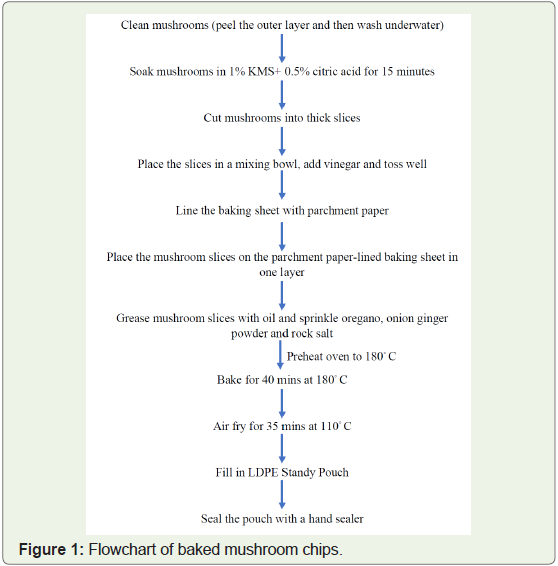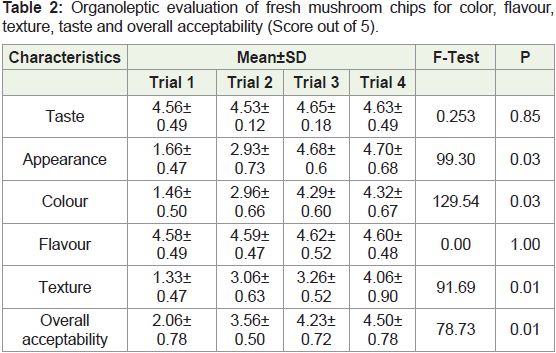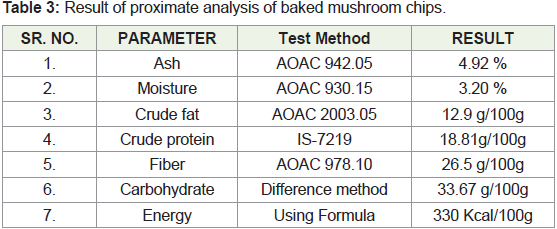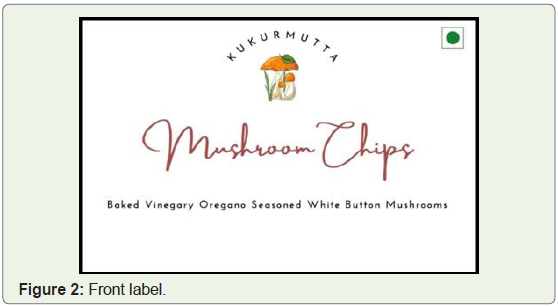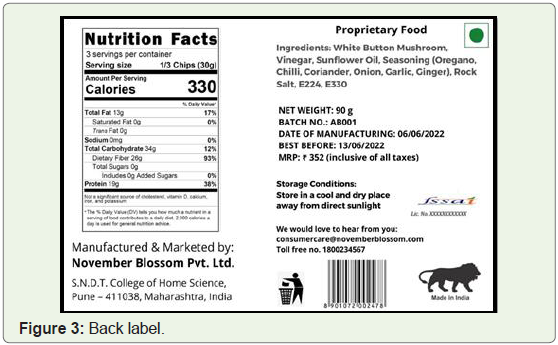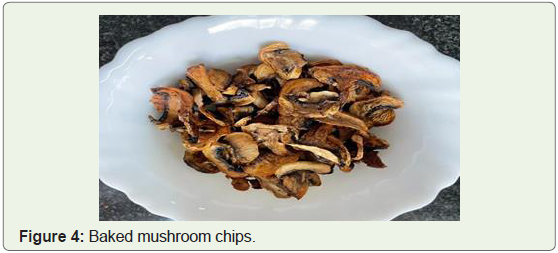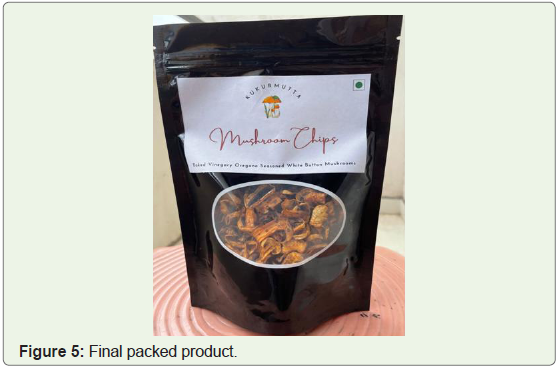Research Article
A Study on the Development and Quality Evaluation of Baked Mushroom Chips as a Source of Unconventional Protein
Shah U* and Salve A
Department of Food Science & Nutrition, S.N.D.T College of Home Science, Karve Road, Pune, India
*Corresponding author: Shah U, Department of Food Science & Nutrition, S.N.D.T College of Home Science, Karve Road, Pune,
India; E-mail: shahurja22@gmail.com
Article Information: Submission: 06/08/2022; Accepted: 03/09/2022; Published: 05/09/2022
Copyright: © 2022 Shah U, et al. This is an open access article distributed under the Creative Commons Attribution License, which
permits unrestricted use, distribution, and reproduction in any medium, provided the original work is properly cited.
Abstract
The world population of human beings has been hyperbolic up to 250% within the last six decades. This increasing global population places a burden on
the food and agriculture sector to feed the population. The want for nutrients cannot be consummated alone by overwhelming typical foods as they’ll be unable
to sustain the population in the future. Need for one such macronutrient, protein will increase that plays a major role in providing amino acids for the growth and
development of body tissues and muscles. Major typical sources of protein within the diet of developing and developed countries will not be sufficient enough
in the next decades. Malnutrition related to protein is yet another major concern in developing countries like India.
The purpose of this study was to develop a high-protein snack from mushrooms as a source of unconventional protein. Four trials were conducted which
varied in their treatments. Chips were prepared using white button mushroom, vinegar, oil, rock salt, oregano, garlic onion powder, citric acid and potassium
metabisulphite (KMS) powder. The chips were analyzed for sensory characteristics using a 5-pointer hedonic scale. According to the results, mushroom chips
pretreated with 1% KMS and 0.5% citric acid were most acceptable (4.50). The crude protein content of mushroom chips was found to be 18.81 gm/100g. The
chips were shelf-stable for 7 days according to shelf-life studies. Since the consumers are not aware of different mushroom recipes, there is a scope for the
food industry to process raw mushrooms into high protein value-added products which are appreciated by the consumers for their taste as well.
Keywords
Mushrooms, Unconventional, Protein, Chips, Sensory evaluation, Value-added product, Functional food
Introduction
When seen globally, the trend in protein consumption has dual
nature. The first side is the overconsumption of protein by western
and developed countries that consume mainly animal protein. And
the second side is the protein deficiency in under-developed and
developing countries where their diet lacks animal protein due to
socioeconomic status and cultural beliefs. Population exploitation
in these countries is also another challenge for agri-food industries
to meet the demands of each individual. Often the diet of such
populations lacks protein as their primary staple diet is cereal and
starch-based. Countries like the U.S.A, Canada, European Union
countries, and many other western countries consume almost twice
their average daily protein requirement [1]. Thus, there is an urgent
need for governments and public health agencies to bridge the huge
gap between overconsumption and protein deficiency in the world.
According to a 2019 report by United Nations International
Children’s Emergency Fund (UNICEF), every second child in India
is affected by some type of malnutrition related to protein deficiency
in their diets. The recommended dietary allowance (RDA) of protein
for an average Indian adult is 0.8 to 1 gm per kg body weight, though;
the average intake is about 0.6 gm per kg body weight. Indian diets
derive almost 60 % of their protein from cereals with relatively low
digestibility and quality [2].
A 2017 survey shows that 73% of Indians are deficient in protein
while above 90% are unaware of the daily requirement of protein. A
survey conducted across 16 cities in India on perception, knowledge
and consumption of protein found a gap in the knowledge of
quality protein in daily diets. Numerous myths surround protein
consumption with 85% believing it leads to weight gain. The diet of Indians is predominantly cereal-based, and 60% of protein is from
cereals which have a lower digestibility and quality.
A study conducted across eight Indian cities found that 71% of
individuals between the ages of 30 to 55 years suffer from poor muscle
health. Data indicates variations between states as well as cities, for
instance, Lucknow at 81% has the highest percentage of individuals
who have poor muscle mass, while Delhi at 64% has a much lesser
percentage [3].
The Indian Consumer Market 2020 shows high monthly
expenditure on cereals and processed foods with only one-third of
the food budget being spent on protein-rich foods. With the rise in
the cases of obesity and diabetes, consumption of protein is the way
forward for Indians as the inclusion of high protein foods in the diet
has been strongly associated with improving insulin response and
reducing diabetes [3].
Need for unconventional sources of protein:
The world population of human beings has hyperbolic up to
250% within the last six decades with a lift from 2.6 to 7 billion and
it’s expected that if the expansion will continue at a similar rate,
the population may be 9 billion by 2042 according to an agency of
United States [4]. This increasing global population places a burden
on the food and agriculture sector to feed the population. The want
for nutrients cannot be consummated alone by overwhelming typical
foods as they’ll be unable to sustain the population in the future.Need for one such macronutrient, protein will increase that plays
a major role in providing amino acids for the growth and development
of body tissues and muscles. Major typical sources of protein within
the diet in developing and developed countries are cereals, meat,
pulses, milk and dairy, fish, seafood, oil crops, vegetables, starchy
roots, eggs, offals, and fruit; however, they’ll not be sufficient enough
in next decades [5]. Therefore, it’s imperative to look for various other
sources of fine quality protein for human consumption apart from
conventional sources.
Apart from conventional sources of protein discussed above,
there are certain unconventional sources which are not only high in
protein but also rich in bioactive compounds which possess healthbenefiting
properties. Examples of such proteins include spirulina
(single cell protein), seitan, duckweed, soy protein, mushrooms and
edible insects.
The purpose of this study was to develop a high-protein snack
from mushrooms. Mushrooms are considered a healthy food because
they are low in calories and fat but rich in proteins and dietary fibre
and contain crude protein in the range of 19-38% on a dry weight
basis [6]. Mushrooms are an excellent source of vitamins, e.g., B
vitamins and vitamin D, and minerals, e.g., phosphorus, magnesium,
selenium, copper, and potassium, and are also rich in dietary fibre,
chitin and β-glucans. Studies have shown that mushrooms are a
rich source of bioactive compounds, e.g., phenolic and flavonoid
compounds that exert antioxidant properties, and these could be
beneficial to human health [7]. Mushrooms are rich in the essential
trace mineral selenium which is a potent antioxidant which helps to
fight against free radicals and increases the strength of bones, teeth,
hair and nails [8].
Material & Methods
Preparation of chips:
For the development of mushroom chips, the following ingredients
are required: white button mushroom, vinegar, oil, rock salt, oregano,
garlic onion powder, citric acid and potassium metabisulphite (KMS)
powder. The above ingredients required for the present experimental
study were purchased from a local supermarket store. OTG and an
Air fryer were used in the preparation of chips. Table 1 shows the
different trials and the variations conducted among these trials.
For the packaging of chips, a stand-upzipper pouch of LPDE (Low-
Density Polyethylene) material was used.The method of preparation
is given in the flow chart (Figure 1).Proximate analysis, sensory analysis and shelf-life study:
Proximate analysis was conducted for parameters such as ash
content, moisture content, crude fat, protein, fibre, carbohydrate and
energy. The analytical tests were performed using standard methods.The sensory analysis was carried out as per the experimental
sampling protocol. 30 untrained panel members were given the
sample for sensory evaluation. A 5-point Hedonic Rating Scale was
used for the parameters: Taste, Appearance, Color, Flavor, Texture
and Overall Acceptability.
The scoring key used was:
5- Liked extremely, 4- Liked moderately, 3- Neither liked nor
disliked, 2- Disliked moderately, 1- Disliked extremely
Mushrooms are highly perishable in nature and deteriorate due
to their high respiration rate and delicate epidermal structure [9].
Therefore, it is very important to study the shelf life of prepared
mushroom chips. The samples were stored for 15 days to study the
shelf life and determine the best before for chips. Moisture content, total plate count and sensory analysis were carried out on the 0th, 7th
and 15th day.
Statistical analysis:
Analysis of variance (ANOVA) was applied to analyze and
interpret the results. For statistical analysis, SPSS software version 16
was used and significance was accepted at p ≤0.05.Results & Discussion
The data for organoleptic evaluation of four trials reveals
that amongst the trials there was a highly significant difference in
texture and overall acceptability (p 0.01); a significant difference in
appearance and colour (p 0.03) and no significant difference in taste
and flavour characteristics (p≥0.05) (Table 2).
Table 2: Organoleptic evaluation of fresh mushroom chips for color, flavour,
texture, taste and overall acceptability (Score out of 5).
A significantly higher score for texture (4.06) and overall
acceptability (4.50) was recorded for mushroom chips pretreated
with 1% KMS and 0.5% citric acid (trial 4), whereas the lowest score
was recorded for trial 1. A significantly higher score for appearance
(4.70) was recorded for mushroom chips treated with 1% KMS and
0.5% citric acid, which was on par with mushroom chips treated with
0.5% KMS and 0.025% citric acid (4.68). A significantly higher score
for colour (4.32) was recorded for mushroom chips treated with 1%
KMS and 0.5% citric acid, which was on par with mushroom chips
treated with 0.5% KMS and 0.025% citric acid (4.29). The highest
score for taste (4.65) and flavour (4.62) was recorded for mushroom
chips treated with 0.5% KMS and 0.025% citric acid.
Mushroom chips were most acceptable when they were pretreated
with 1% KMS and 0.5% citric acid (trial 4) according to the results of
sensory evaluation. This was due to the effect of salt and citric acid,
which enhances the taste and flavour and potassium metabisulphite
helped in better retention of colour and appearance which is in
agreement with the results of Dadasaheb Desayi [10].
The protein content of the final product was 18.81g/100g which
is considered a high protein source (Table 3). The product has a shelf
life of 7 days, after which it develops a rancid flavor (Table 4).
The labelling of the product was designed bearing in mind all
these regulations given by Food Safety and Standards (labelling and
display) Regulations, 2020 (Figure 2-5).
Conclusion
Although mushrooms are a rich source of protein and are not
very expensive as compared to meat and poultry the consumption rate in India is meagre. This is due to the fact that the consumers
are not aware of the nutrient quality of mushrooms and their health
benefits. Consumers are hesitant to consume mushrooms due to
certain myths, aversion toward the taste/texture of mushrooms or
lack of knowledge to prepare different mushroom recipes.
Since the consumers are not aware of different mushroom recipes,
there is a scope for the food industry to process raw mushrooms into
value-added products which are appreciated by the consumers for
their taste as well. Processing adds shelf-life to mushrooms which are
otherwise highly perishable. Apart from chips, it can also be processed
into flours, noodles, pickles, biscuits, etc. which will not only provide
variety to the customer but also a healthy alternative.

